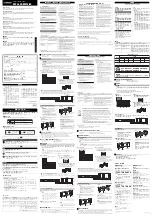
6
CAUTION: The brake valve may be light clamped in a bench
vise, but overclamping may damage the valve and
cause leakage and/or malfunction. If a vise is used,
clamp on the supply and delivery ports on opposing
sides of the valve’s primary body.
1. Remove all air line fittings and plugs.
2. On valves that have a manifold on the engine
compartment side, remove the bolts that secure the
manifold to the valve. Separate the valve and manifold
and remove the sealing rings and adapter sleeves. (See
Figure 2.)
3. Remove the four cap screws(16) that secure the primary
body to the secondary body. Separate the two body
halves and remove and discard o-ring(17).
4. Pull secondary piston(18) out of the primary body and
remove and discard o-rings(19 & 20).
5. Remove and discard snap ring(10) from the secondary
body while manually holding and compressing valve
seat(11) in place.
6. Slowly release valve seat(11), allowing it to rise out of
the body. Remove the valve seat, then remove and discard
o-ring(12).
7. Remove and discard valve assembly(13) along with its
o-ring(15) from the secondary body. Remove the valve
assembly return spring(14).
8. Carefully remove and discard exhaust diaphragm
screw(24), diaphragm washer(25), diaphragm(26), and
diaphragm retainer(27) from the secondary body. NOTE:
Some E-14
™
brake valves have a threaded exhaust port
instead of items 24-27.
9. Using light force, push piston(2) into the primary body
until piston retaining ring(1) is fully visible. Remove piston
retaining ring(1), taking care not to damage the piston
bore in the body.
10. Gently tap the primary body on a soft surface to remove
piston(2). Remove and discard o-rings(3 & 5) and both
wear rings(4) from piston(2).
11. Place the piston on a flat surface. Using finger force,
depress and hold spring retainer(7), then remove and
discard retaining ring(6) from piston(2).
12. Gently release spring retainer(7), allowing it to rise out
of the piston. Remove spring retainer(7) and graduating
spring(8) from piston(2).
13. Remove and discard rubber spring(9) from the interior of
piston(2).
14. Remove and discard snap ring(10) from piston(2) while
manually holding and compressing valve seat(11) in
place.
15. Slowly release valve seat(11), allowing it to rise out of
piston(2). Remove valve seat(11), then remove and discard
o-ring(12).
16. Remove and discard valve assembly(13) along with its
o-ring(15) from piston(2). Remove valve assembly return
spring(14).
CLEANING & INSPECTION
1. Using mineral spirits or an equivalent solvent, clean and
thoroughly dry all metal parts.
2. Inspect the interior and exterior of all metal parts that
will be reused for severe corrosion, pitting, or cracks.
Superficial corrosion and/or pitting on the exterior portion
of the secondary and primary bodies is acceptable.
3. Inspect the bores of both bodies for deep scuffing or
gouges.
4. If primary piston(2) is reused, make certain that vents
“A & B” are open and free of obstructions. (See Figure
2.)
5. Make certain vent “C” is open in the primary body of the
valve. (See Figure 2.)
6. Inspect the pipe threads in both bodies. Make certain
they are clean and free of thread sealant.
7. Inspect pedal assembly and mounting plate. Make certain
the pedal roller turns freely and is lightly lubricated.
Note: Some pedal assemblies, not furnished by Bendix,
do not employ a roller. In this case, make certain the
mechanism in use moves across the plunger smoothly,
without binding or sticking. Inspect plunger for excessive
scuffing or wear. Check the plunger bore in the mounting
plate for excessive wear, shown by “egg shaping” (bell
mouthing). Inspect mounting plate for severe corrosion,
paying particular attention to the area around the pivot
pin bores.
8. If the brake valve uses a rubber boot between the plunger
and mounting plate, inspect the boot for deterioration
or cracking.
9. Inspect all air line fittings and plugs for corrosion Clean
all old thread sealant from the pipe threads.
Any valve or pedal assembly component that does not meet
the inspection criteria listed above should be discarded and
replaced before proceeding.
ASSEMBLY (SEE FIGURE 9)
1. Using silicone lubricant (650-M), lightly coat all o-rings,
o-ring bores, and grooves, except for the secondary
piston o-rings(19 and 20). Lightly lubricate primary
piston(2) bore into which graduating spring(8) is installed.
With the 328-M lubricant, lightly coat o-rings (19 and
20) and o-ring grooves on secondary piston(18).


























